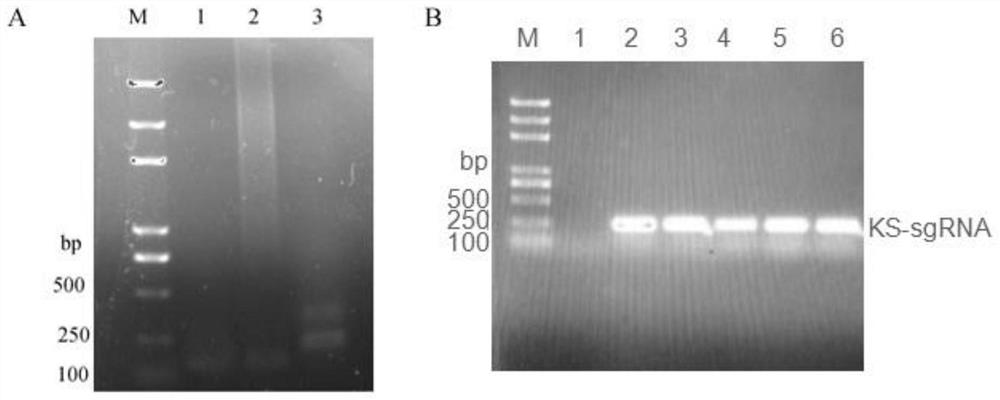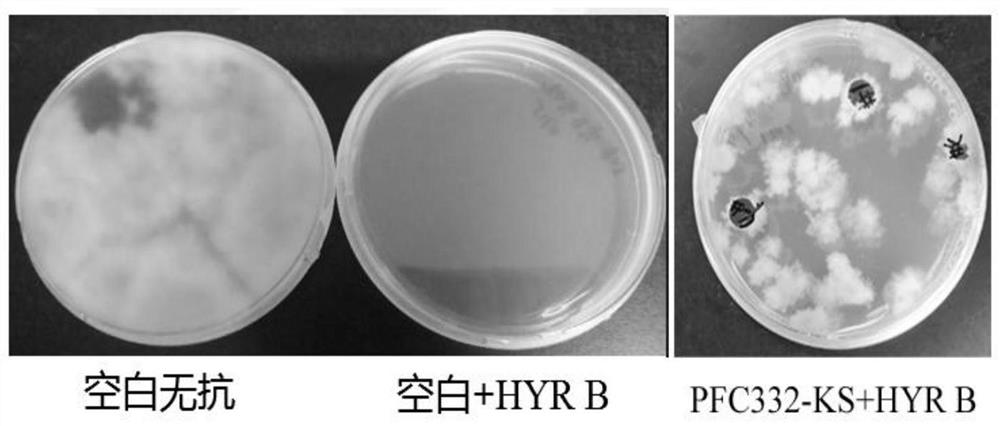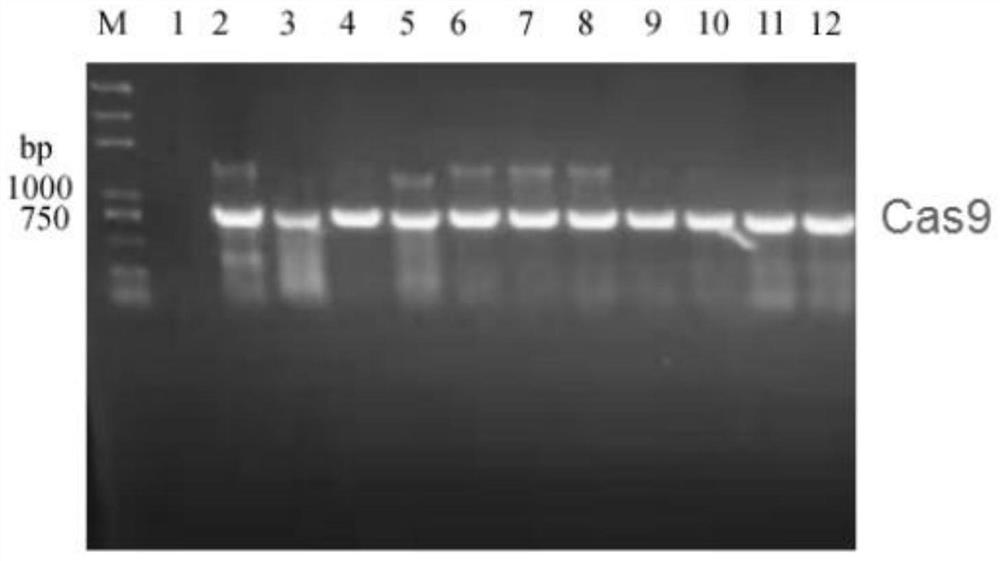A CRISPR/Cas9 vector suitable for Phomopsis fs508 and its construction method and application
A technology of Phomopsis and a construction method, applied in the field of molecular biology, can solve problems such as low knockout efficiency, and achieve the effects of promoting genetic engineering transformation, simple construction and high gene knockout efficiency
- Summary
- Abstract
- Description
- Claims
- Application Information
AI Technical Summary
Problems solved by technology
Method used
Image
Examples
Embodiment 1
[0025] Example 1: Construction of targeting lithocarpins biosynthesis gene knockout vector
[0026] Design the target sequence 5'-gagaaggcttacgctcaggt-3' of the KS module.
[0027] On the basis of the pFC332 plasmid, pFC332 was digested with PacI and BglII sites, and a sequence was inserted: 5S rRNA-KS-sgRNA fragment (that is, 5S rRNA promoter-targeting sequence-sgRNA-sgRNA terminator, which is contained in The applicable 5S rRNA promoter in P.lithocarpus FS508, the sgRNA targeting sequence backbone gene and its terminator in P.lithocarpus FS508) enable the recombinant plasmid to stably express Cas9 protein and transcription sgRNA (the plasmid was named pFC332-sgRNA-KS). The primer 5S rRNA-sgRNA-F contains the target sequence gagaaggcttacgctcaggt in the KS module.
[0028] The primers designed for constructing the vector are shown in Table 1, and the pFC332-sgRNA-KS vector was constructed by restriction enzyme ligation. The construction method is as follows:
[0029] Table...
Embodiment 2
[0034] Example 2: Knockout of P. lithocarpus FS508 lithocarpins biosynthetic genes:
[0035] The method for introducing exogenous genes into P.lithocarpus FS508 protoplasts is as follows:
[0036] (1) The preparation method of P.lithocarpus FS508 protoplasts is as follows:
[0037] Pick an appropriate amount of mycelium of P.lithocarpus FS508 and inoculate it in 200mL PDB liquid medium, and culture it at 30°C and 180r / min for 7 days. Filter the bacterial solution with two layers of gauze, select 2 g (wet weight) of well-growth bacterial spheres into a 50 mL centrifuge tube, and wash twice with PBS buffer to fully wash away the residual PDB medium. Weigh 0.10g lyase and dissolve in 20mL KC buffer (0.6M KCl, 0.05M CaCl 2 ), and filtered with a 0.22 μm filter membrane, and added to the washed bacterial balls. Cleavage at 28°C and 68rpm for about 3 hours. Filter the lysate with a 200-mesh filter, filter the mycelium, and then filter again with 6 layers of lens tissue, centrifu...
Embodiment 3
[0043] Embodiment 3: comparative analysis of lithocarpins in KS mutant strain and wild strain
[0044] Comparative analysis of the production of novel lithocarpins compounds from wild P.lithocarpus FS508 and recombinant P.lithocarpus FS508.
[0045] Recombinant P.lithocarpus FS508 (KS mut P.lithocarpus FS508) and wild P.lithocarpus FS508 were inoculated, cultured in YPD medium, and cultured at 28°C for 7 days. Fermentation broths of wild and recombinant P.lithocarpus FS508 were collected, extracted with an equal volume of ethyl acetate, and concentrated by rotary evaporation. The ethyl acetate crude extracts of wild P.lithocarpus FS508 and recombinant P.lithocarpus FS508 were analyzed by HPLC and Agilent 6430 liquid mass spectrometer, and the novel lithocarpin A and Tenellone B in P.lithocarpus FS508 were used as standards. use C 18 A column (4.6×250mm) was used for analysis and detection. The detection conditions are as follows: the eluent increases from 30% methanol to 10...
PUM
 Login to View More
Login to View More Abstract
Description
Claims
Application Information
 Login to View More
Login to View More - R&D
- Intellectual Property
- Life Sciences
- Materials
- Tech Scout
- Unparalleled Data Quality
- Higher Quality Content
- 60% Fewer Hallucinations
Browse by: Latest US Patents, China's latest patents, Technical Efficacy Thesaurus, Application Domain, Technology Topic, Popular Technical Reports.
© 2025 PatSnap. All rights reserved.Legal|Privacy policy|Modern Slavery Act Transparency Statement|Sitemap|About US| Contact US: help@patsnap.com



